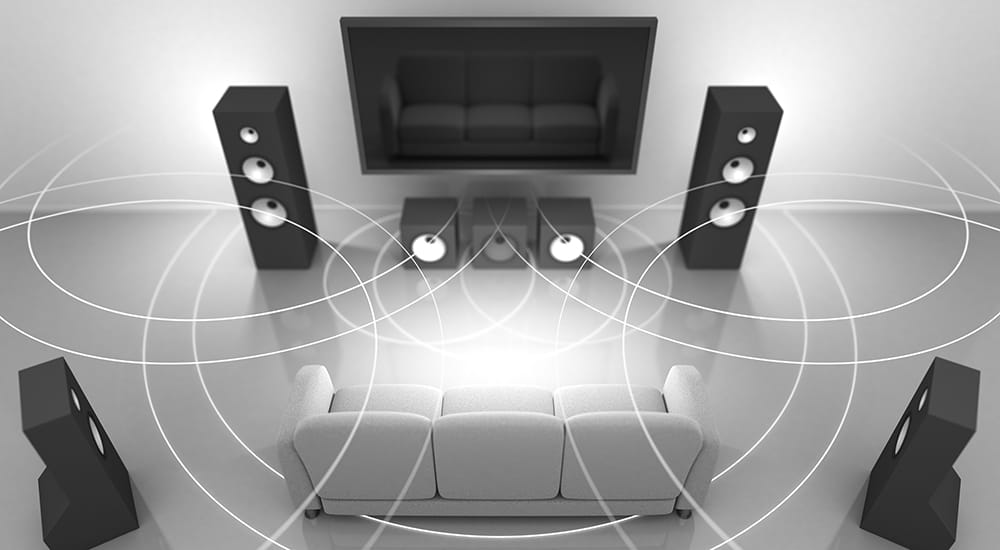The numbers 5.1 and 7.1 are usually followed by the word 'channels'. Each plays back sound on 6 or 8 different channels respectively, each assigned to a speaker. The first number, therefore, refers to the number of speakers in the sound system chain.
The second number denotes the number of subwoofers, most often there is 1 unless the room is very large.
Thus, a 5.1 system uses 6 channels for its sound playback and the 7.1 system uses 8.

The simple difference is 2 speakers and the overall configuration.
The 5.1 system is the most common as it is compatible with most regular home theater room sizes.
The layout is usually thus:
Three speakers at the front of the room, 1 beneath the screen or TV, and 1 in either corner.
The remaining 2 surround sound speakers should be positioned at either side of the listening/viewing areas for maximum effect.
For larger rooms where there is a void behind the rear seats, it is advisable to use the 7.1 setup. This prevents the sound from being swallowed up by the space.
7.1 is configured in the same way as the 5.1, with the 2 additional speakers in either rear corner of the room.
These speakers are often mounted at an angle in the top corners of the room. This not only frees up floor space for easy passage, but it also adds an extra dimension to the sound dynamic.
You might think that bigger is better and the more speakers you have, the better the sound will be in your home theater.
This is not the case. Using a 7.1 system in a small room can create uneven audio.
The large rear speakers might overpower those at the front and create an odd listening experience.
Both sound effects, speech, and music can be affected, resulting in poor sound clarity and distortion.
Conversely, a large room needs a 7.1 system at least. The audio should match that of movie theater standard and this can only be achieved by correctly positioned speakers all around the room.
In the correct sized room, the 7.1 setup creates a rich, deep, and accurate surround sound system.
The most commonly used setup for home movie theaters and also the one most used in Home Theater in a Box Systems.
Advantages
Disadvantages
Advantages
Disadvantages
There are three main considerations when selecting your operating system. The room and what's inside it does matter, as does the positioning of the speakers.

Multiple speakers are great in a large room, in a small room all they will achieve is loudness.
Instead, for a room below 350ft², rely on a 5.1 system. Otherwise, sound waves will jumble, resulting in a sound with poor definition.
Similarly, a larger room with a 5.1 system might find a loss in sound, with audio struggling to project everywhere around the space.
Rooms with vaulted ceilings tend to produce echo and create poor bass reproduction.
Sound will find the space behind the seats and fade, leaving an inaccurate and dull noise in your home movie theater.
Upgrading to a 7.1 system ensures full surround sound in every corner of the room.
If you're at the stage where you're choosing equipment, then you should have already taken care of the soundproofing element. It serves not just to stop people outside of the room overhearing, but also to keep all of the good sound sealed inside for the pleasure of the listeners.
The correct balance of furnishings can help with acoustic treatment. Too many hard surfaces allow the sound to reflect and bounce around randomly, altering its designed format.
Soft furnishings absorb sound reflections and dampen the audio to create a great listening environment.
Keep your furniture centralized, don't give the sound from your speakers a hard surface to bounce off.
Sound reflection is bad and should be avoided at all costs. When sound waves reflect they leave behind reverberation and echoes. Placing the speakers in the correct configuration will prevent this.
If you buy a Home Theater Box kit, each speaker will have its best position marked. Stick to it, a speaker marker F/L should go front and left for a clear audio reason.
In a 7.1 channel format, installing the speakers in the rear top corners of the room angled slightly inwards will improve the depth and tone of the audio.
A subwoofer is a speaker that handles the low frequencies or bass that normal speakers are not capable of reproducing.
Without at least one subwoofer, the listener would miss out on some vital sound, that special sound that is rich in movies and gives it a 3-dimensional feel.
Subwoofers of old were massive pieces of equipment, that might spoil the aesthetics of a home theater.
Recent technologies have seen great improvement in amps, enabling them to power scaled-down subwoofers. They can even be bought in designs that complement your speaker system.
As the .1 part of 5.1 and 7.1, we are being led to believe that 1 subwoofer is sufficient in a regular-sized room.
However, speak to an audio pro and they might tell you differently.
Bass waves are larger than smaller frequency sound waves, and, as such, they travel in peaks and troughs. A second subwoofer would serve to fill in each of the dips, and combined the 2 speakers serve to provide the perfect audio experience of the bass notes on the lower register.
Those in the know suggest that for each row of seats in a home movie theater, there should be 2 subwoofers.
Making the choice between 5.1 and 7.1 depends on many factors, but overall, the main consideration should be the room size.
For a reasonably sized room, a 5.1 channel format is sufficient. Don't be tempted to forsake good quality audio for volume.
Though, if the sound purists are to be believed, consider a second subwoofer to perfectly balance out the sound.
